2.1 文献检索结果及质量评价 从6个电子数据库(Cochrane图书馆、PubMed、Web of Science、中国知网、万方、维普)中提取了相关文献1 215篇。使用Endnote X9软件删除重复项后,还剩下681篇;阅读题目和摘要进行初筛,排除了503篇不相关的文献;剩余178篇,根据纳入和排除标准排除文献146篇;仔细阅读其余的32篇文章,通过浏览文献中的参考文献,纳入了0个其他的研究;由于以下原因排除了另外25篇文章:没有进行对比(n=11),没有需要的数据(n=8),综述(n=4),其他(n=2)。最后1990年至2020年6月之间发表的7项研究符合纳入标准[9-15],纳入荟萃分析。详细的文献筛选过程见图1。表1详细列出了纳入文献的一般特征。
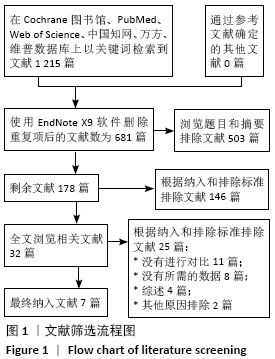

7项研究总计3 464例患者(氨甲环酸 = 1 508例,ε-氨基己酸 = 1 956例)。其中4项为随机对照研究[9,12,14-15],Cochrane偏倚风险评估为低风险(图2,3);3项为回顾性对照研究[10-11,13],研究质量由纽卡斯尔-渥太华量表评估,其中2项为高质量研究,1项为中等质量研究(表2)。纳入文献的样本量至少为32例,最多为820例;随访时间为1-3个月不等。
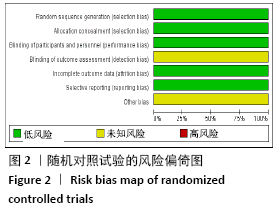
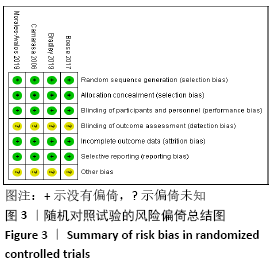

4项随机对照试验研究均描述了随机序列的产生和分配隐瞒,均描述了双盲;文献中对失访和报告等偏倚进行了详细的报道,并将其归类为低风险偏倚;对测量和其他偏倚描述的较差。3项队列研究的文献质量采用纽卡斯尔-渥太华量表进行评价,结果显示非随机对照试验偏倚风险相对较低。
2.2 Meta分析结果
2.2.1 总失血量 4项研究(共733例患者)比较了两种药物使用后的总失血量[9,12-13,15],森林图显示两者差异无统计学异质性(I2=44%,P=0.15),采用固定效应模型。结果证明两种药物之间差异有显著性意义,氨甲环酸组的总失血量少于ε-氨基己酸组(WMD=-0.44,95%CI:-0.59至-0.30,P < 0.000 01),见图4。
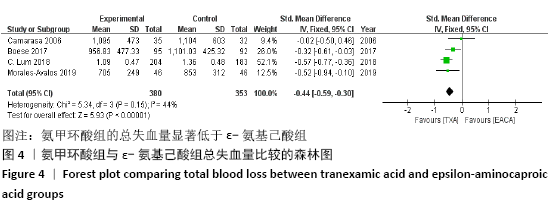
2.2.2 术中失血量 3项研究(共428例患者)比较了两种药物使用后的术中失血量[12,14-15],森林图显示两者差异无统计学异质性(I2=35%,P=0.22),采用固定效应模型。结果证明两种药物之间差异无显著性意义(WMD=-2.49,95%CI:-7.77-2.78,P=0.35),见图5。

2.2.3 红细胞容积损失量 2项研究(共332例患者)比较了两种药物使用后的红细胞容积损失量[12,14],森林图显示两者差异有统计学异质性(I2=95%, P < 0.000 01),采用随机效应模型。结果证明两种药物之间差异无显著性意义(WMD=-0.87,95%CI:-1.96-0.22,P= 0.12),见图6。

2.2.4 红细胞压积下降量 2项研究(共159例患者)比较了两种药物使用后的红细胞压积下降量[9,15],森林图显示两者差异有统计学异质性(I2=62%,P=0.11),采用随机效应模型。结果证明两种药物之间差异无显著性意义(WMD=-0.41,95%CI:-1.90-1.07,P=0.59),见图7。
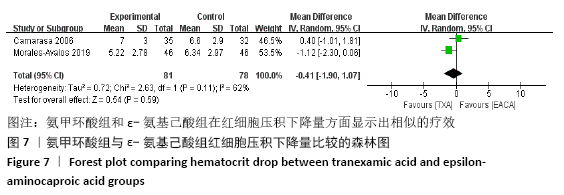
2.2.5 血红蛋白下降量 4项研究(共 1 734例患者)比较了两种药物使用后的血红蛋白下降量[9,11,14-15],森林图显示两者差异无统计学异质性(I2=43%,P=0.15),采用固定效应模型。结果证明两种药物之间差异有显著性意义,氨甲环酸组血红蛋白下降量小于ε-氨基己酸组(WMD=-0.19,95%CI:-0.26至-0.12,P < 0.000 01),见图8。
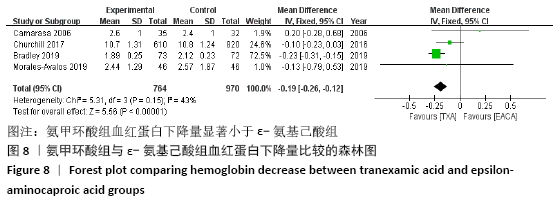
2.2.6 单位红细胞输血量 2项研究(共479例患者)比较了两种药物使用后的单位红细胞输血量[13,15],森林图显示两者差异无统计学异质性(I2=0%,P= 0.57),采用固定效应模型。结果证明两种药物之间差异有显著性意义,氨甲环酸组单位红细胞输血量小于ε-氨基己酸组(WMD=0.14,95%CI:0.04-0.42,P=0.000 6),见图9。

2.2.7 每例患者单位输血量 3项研究(共2 653例患者)比较了两种药物使用后每例患者的单位输血量[9-11],森林图显示两者差异有统计学异质性(I2= 56%,P=0.11),采用随机效应模型。结果证明两种药物之间差异无显著性意义(WMD=0.00,95%CI:-0.05-0.06,P = 0.94),见图10。

2.2.8 输血人数 5项研究(共2 890例患者)比较了两种药物使用后的输血人数[9-11,14-15],森林图显示两者差异无统计学异质性(I2=9%,P=0.35),采用固定效应模型。结果证明两种药物之间差异无显著性意义(WMD=1.31,95%CI:0.94-1.83,P=0.11),见图11。
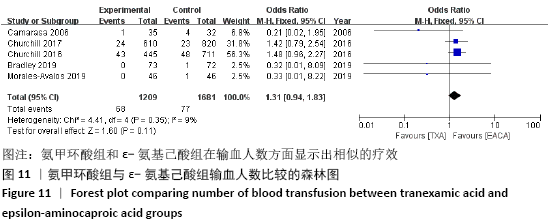
2.2.9 引流管引流量 2项研究(共237例患者)比较了两种药物使用后的引流管引流量[14-15],森林图显示两者差异有统计学异质性(I2=99%,P < 0. 000 01),采用随机效应模型。结果证明两种药物之间差异无显著性意义(WMD=-2.11,95%CI:-5.73-1.52,P=0.25),见图12。

2.2.10 住院时间 3项研究(共1 769例患者)比较了两种药物使用后的住院时间[11-12,14],森林图显示两者差异无统计学异质性(I2=0%,P=0.77),采用固定效应模型。结果证明两种药物之间差异无显著性意义(WMD=-0.01,95%CI: -0.11-0.08,P=0.80),见图13。

2.2.11 止血带时间 2项研究(共280例患者)比较了两种药物使用后的止血带时间[12,15],森林图显示两者差异无统计学异质性(I2=0%,P=0.94),采用固定效应模型。结果证明两种药物之间差异无显著性意义(WMD=1.23,95%CI: -2.73-5.20,P=0.54),见图14。

2.2.12 手术时间 3项研究(共353例患者)比较了两种药物使用后的手术时间[9,12,15],森林图显示两者差异无统计学异质性(I2=0%,P=0.39),采用固定效应模型。结果证明两种药物之间差异无显著性意义(WMD=1.42,95%CI: -2.23-5.07,P=0.45),见图15。

2.2.13 肺部并发症 2项研究(共332例患者)比较了两种药物使用后的肺部并发症[12,14],森林图显示两者差异有统计学异质性(I2=63%,P=0.10),采用随机效应模型。结果证明两种药物之间差异无显著性意义(WMD=1.30,95%CI:0.06-28.39,P=0.87),见图16。
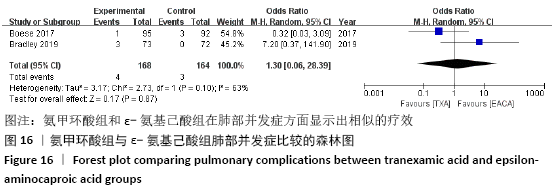
2.2.14 心脏并发症 3项研究(共424例患者)比较了两种药物使用后的心脏并发症[12,14-15],森林图显示两者差异无统计学异质性(I2=0%,P=0.77),采用固定效应模型。结果证明两种药物之间差异无显著性意义(WMD=2.33,95%CI:0.59-9.12,P=0.23),见图17。
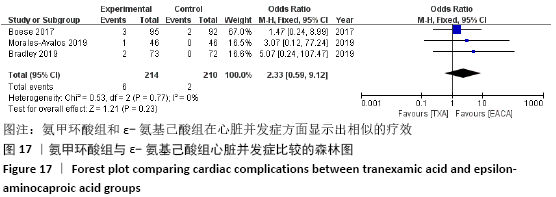
2.2.15 再入院人数 2项研究(共2 586例患者)比较了两种药物使用后的再入院人数[10-11],森林图显示两者差异无统计学异质性(I2=0%,P=0.96),采用固定效应模型。结果证明两种药物之间差异无显著性意义(WMD=0.94,95%CI:0.59-1.49,P=0.79),见图18。
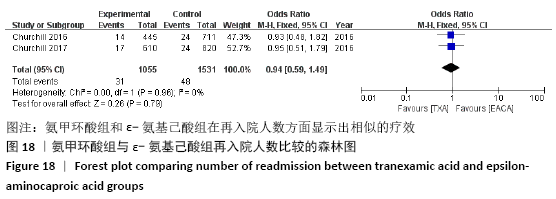
2.3 发表偏倚评价 采用Review Manager 5.3软件进行发表偏倚检验。以纳入研究最多的输血率一项做漏斗图,并把输血率分为随机对照试验组和非随机对照试验组做亚组分析,漏斗图中的6个点大致对称分布,表明发布偏倚对结果的影响较小,见图19。

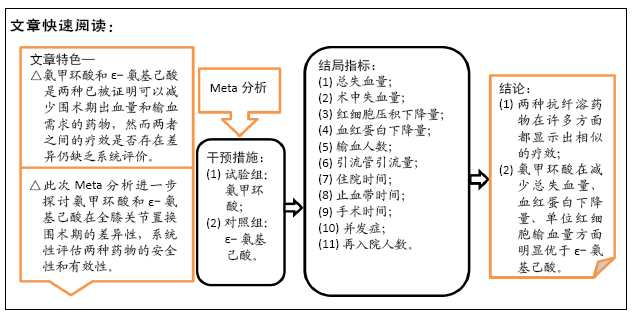





















 LIU等[25]通过3个随机对照试验和1个非随机对照试验分析了1 714例患者,得出与ε-氨基己酸相比,氨甲环酸可显著减少总失血量和术后血红蛋白下降,而在输血率、住院时间和术后并发症发生率方面两者差异无显著性意义。这与作者得出的结果一致,作者还得出氨甲环酸可显著减少单位红细胞输血数量。
LIU等[25]通过3个随机对照试验和1个非随机对照试验分析了1 714例患者,得出与ε-氨基己酸相比,氨甲环酸可显著减少总失血量和术后血红蛋白下降,而在输血率、住院时间和术后并发症发生率方面两者差异无显著性意义。这与作者得出的结果一致,作者还得出氨甲环酸可显著减少单位红细胞输血数量。